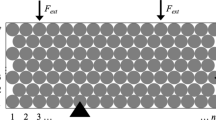Abstract
A topology optimization method is used to design two dimensional periodic structures with desirable transmission properties by distributing two materials of different permittivity over a rectangular representative cell. A plane wave expansion of the electric field at the input and output boundaries is used in the analysis. This allows non-homogeneous material distributions near the boundaries. Numerical examples are used to verify the robustness of the method and to investigate the importance of retaining higher modes in the expansions. It is found that the optimization problem typically admits possibly many local optima and the relevance of higher modes depends on the nature of the solution found. In some instances, higher modes play an important role and using only the dominant mode in the analysis is shown to result in errors in the evaluation of the performance of the design.











Similar content being viewed by others
References
Bao G (1995) Finite-element approximation of time-harmonic waves in periodic structures. SIAM J Numer Anal 32(4):1155–1169
Bendsøe MP (1990) Optimal shape design as a material distribution problem. Struct Optim 1(4):193–202
Borel PI, Harpoth A, Frandsen LH, Kristensen M, Shi P, Jensen JS, Sigmund O (2004) Topology optimization and fabrication of photonic crystal structures. Opt Express 12(9):1996–2001
Bourdin B (2001) Filters in topology optimization. Int J Numer Methods Eng 50(9):2143–2158
Bruns TE, Tortorelli DA (2001) Topology optimization of non-linear elastic structures and compliant mechanisms. Comput Methods Appl Mech Eng 190(26–27):3443–3459
Diaz AR, Benard A (2003) Designing materials with prescribed elastic properties using polygonal cells. Int J Numer Methods Eng 57(3):301–314
Dossou K, Byrne MA, Botten LC (2006) Finite element computation of grating scattering matrices and application to photonic crystal band calculations. J Comput Phys 219(1):120–143
Duhring MB, Sigmund O, Feurer T (2010) Design of photonic bandgap fibers by topology optimization. J Opt Soc Am, B 27(1):51–58
Fuchi K, Diaz AR, Yamada T, Nishiwaki S (2009) A level set-based topology optimization method for power flow control in electromagnetics. In: 8th congress on structural and multidisciplinary optimization. Lisbon, Portugal
Jensen JS, Sigmund O (2004) Systematic design of photonic crystal structures using topology optimization: low-loss waveguide bends. Appl Phys Lett 84(12):2022–2024
Mlejnik HP, Schirrmacher R (1993) An engineer’s approach to optimal material distribution and shape finding. Comput Methods Appl Mech Eng 106(1–2):1–26
Nomura T, Nishiwaki S, Sato K, Hirayama K (2009) Topology optimization for the design of periodic microstructures composed of electromagnetic materials. Finite Elem Anal Des 45(3):210–226
Riishede J, Sigmund O (2008) Inverse design of dispersion compensating optical fiber using topology optimization. J Opt Soc Am, B 25(1):88–97
Rozvany GIN, Zhou M, Birker T (1992) Generalized shape optimization without homogenization. Struct Optim 4(3–4):250–252
Sigmund O (1994) Materials with prescribed constitutive parameters: an inverse homogenization problem. Int J Solids Struct 31(17):2313–2339
Sigmund O, Hougaard K (2008) Geometric properties of optimal photonic crystals. Phys Rev Lett 100(15):153904
Svanberg K (1987) The method of moving asymptotes—a new method for structural optimization. Int J Numer Methods Eng 24(2):359–373
Tsuji Y, Hirayama K, Nomura T, Sato K, Nishiwaki S (2006) Design of optical circuit devices based on topology optimization. IEEE Photonic Technol Lett 18(5–8):850–852
Acknowledgement
This material is based upon work supported, in part, by the US National Science Foundation under Grant No. 0800388. This support is gratefully acknowledged.
Author information
Authors and Affiliations
Corresponding author
Rights and permissions
About this article
Cite this article
Fuchi, K., Diaz, A.R., Rothwell, E. et al. Topology optimization of periodic layouts of dielectric materials. Struct Multidisc Optim 42, 483–493 (2010). https://doi.org/10.1007/s00158-010-0522-x
Received:
Revised:
Accepted:
Published:
Issue Date:
DOI: https://doi.org/10.1007/s00158-010-0522-x




